By Bas Martens
During World War II, several models of so-called grenade rifles were developed in occupied Czechoslovakia. Until recently, these were completely unknown.
The most beautiful discoveries sometimes start with no more than a slip of paper. In this case, it was a few lines in a long list of weapons projects under development in Germany and the occupied territories in April, 1944. The list was prepared for the first meeting of the Sonderkommission Infanteriewaffen, a special committee directly under the Minister of Armaments Albert Speer, which had to decide on the projects that served the German war effort best.
Somewhere in the middle of the 186 projects in this list, a fascinating weapon is mentioned: a ‘Gewehrgranaten-Büchse’, which fired the German 46mm and 61mm Gewehr Panzergranaten (anti-tank grenades): In short, a grenade rifle.
According to the scant information in the list, the order for the development was given by the SS Waffenamt and the project was carried out by the Waffenwerke Brünn, the Czech small arms factory in Brno (Zbrojovka Brno). The list states that, at that point, four prototypes were made, each 62.5 centimeters long and weighing 5.5 kilos. Shooting trials were being held.

Unknown
The intriguing thing about this statement, of course, is that thus far these weapons have never been shown. Even the former German quarterly Waffen Revue has never mentioned them, though it was known for its thorough documentation about German war developments. Alas, one would say, one more piece of history lost.
Fortunately, things turned out differently because there is such an institute as the Army Museum in Prague – a museum with a fantastic collection, and an old-fashioned way of preserving it. It got me thinking; a museum in Prague and a war-time development in Brno? Could it be that one of these grenade rifles had been saved?
On a visit to the museum with my friend Leszek Erenfeicht, I took the list of projects of the Sonderkommission with me. Our host, curator Jan Skramoussky, thought for a moment, said, “I’ll have a look” and then disappeared into the catacombs. After fifteen minutes he came stumbling back. Not with one, but with four grenade rifles. And all four were different!
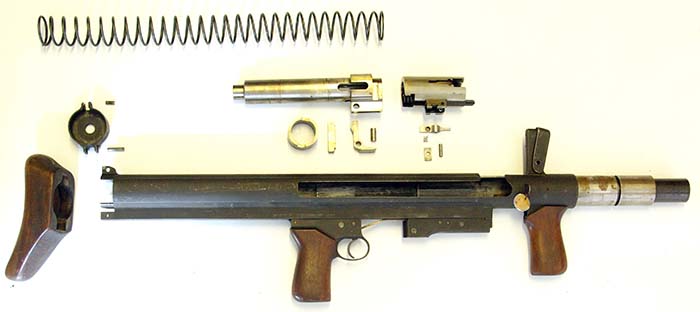
Unique
These weapons are truly unique. Since my visit to Prague, I have tried to find further information, but without any success. Regrettably, we must do only with a detailed description.
First the big picture. There are four shoulder firearms with a rifled barrel for firing rifle grenades, and with a special mechanism to absorb the recoil forces. All four are marked with a trademark and/or model designation and serial number:
1. Factory marking Z in circles, model designation ZK 424, serial number SK 0051.
2. Factory marking WAFFENWERKE BRÜNN A.G., no model designation, serial number No. 10.
3. Factory marking WAFFENWERKE BRÜNN A.G., model designation GBSS43, serial No. 07.
4. Factory marking WAFFENWERKE BRÜNN A.G., model designation GBSS43, serial No. 11-IV.
Weapon numbers 1 and 3 have a rotating barrel with a bayonet closure. Weapons 2 and 4 have a tilting barrel. The barrels are chambered for a special 7.9mm cartridge for firing rifle grenades. Their front section is rifled.
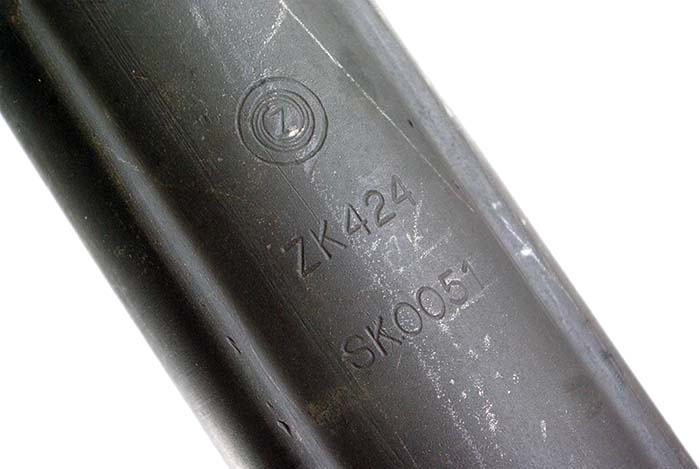
The letters ZK stand for a design of the Koucký brothers, while GBSS43 stands for Gewehrgranaten-Büchse SS 43. This is a rather enigmatic designation. Would the weapons have already been developed in 1943? And if so, how is it that in April 1944 only four pieces were available for testing? Unfortunately, we do not have an answer.
Another question concerns the chronological order of these four guns. The most logical seems the one in which they are listed here. ZK 424 is a factory designation, which was used for weapons that were still under development. There is a good analogy: the ZK 403 submachine gun, also by Koucký. Only when the SS planned to adopt it was renamed Maschinenpistole 42. Therefore, it seems plausible that the ZK 424 preceded the other three models. Weapon number two seems a logical next step, with only the brand name used by the Germans and no model designation. And then there are the two specimens with the manufacturer’s name and model designation, one with a number 7 and one with number 11. We can only guess at the meaning of the Roman numeral IV added to the last gun’s serial number. The fourth version of serial number 11? That does not make sense.
In the following, the four arms will be discussed separately. Unfortunately, many questions remain unanswered. But in any case, the existence of these weapons is now known.
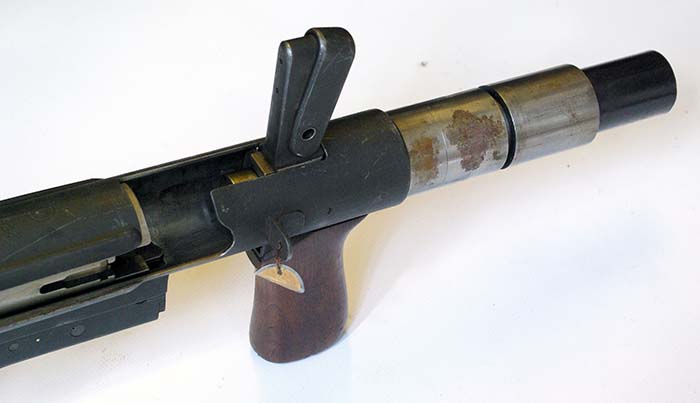
ZK 424
Its outer appearance is simple: a tubular housing of sheet steel with a wooden butt-plate and two pistol grips, identical to that of the vz. 26 light machine gun and its successors (the front grip being reversed). Internally it is a different story. The mechanism of ZK 424 consists of three complex, solid steel main parts: the barrel with its locking lugs, the breech head with the firing pin, extractor and ejector, and the breech block. At rest, all three are interconnected. The barrel has two locking lugs at the rear, which fall into corresponding recesses in the breech head – the reverse of a bolt action rifle. The bolt head has a rear recess that falls like a bridge over the narrowed front section of the breech block.
To load the weapon, the barrel must be opened. The ZK 424 barrel has eight lands and grooves. On the right is a handle, slid with two rails in recesses of the barrel block, and fastened with a thick screw.
The base of the handle has a spring-loaded cam, which rest in a recess of the breech block, just ahead of the extractor, when the weapon is closed. If the spring-loaded lever of the handle is pressed, the cam is pulled inward. The barrel can be rotated upwards, which causes the lugs to rotate out of their recesses in the breech head. If the barrel is free, it can be moved forward so that a cartridge can be loaded in the chamber. When unlocking the barrel, a sloping cam pushes the firing rod backwards, so that the firing pin is cocked.
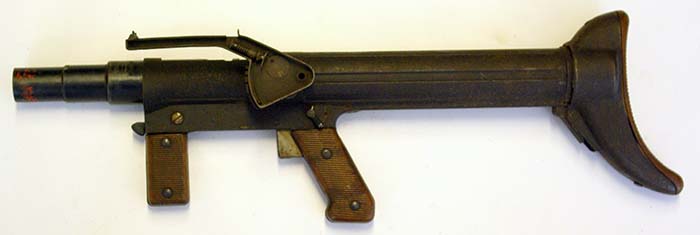
When the barrel is closed, it moves the cartridge in front of the firing pin. The firing pin is cocked. The only thing left is to load a rifle grenade in the muzzle end.
The ZK 424 has no safety, but a peculiar trigger mechanism. This consists of two vz. 26 pistol grips with part of the original trigger mechanism. The rear one is still clearly recognizable. The front one has the pistol grip and trigger removed (the hole for the shaft of the pistol grip is still visible). A plate extends from the rear to the front unit. When the trigger is pulled, that plate is pulled backwards. The sear in the front unit pivots, thus permitting the firing pin to strike forward.
After the shot the whole mechanism moves backwards in the receiver to soften the recoil. The huge recoil spring captures the moving parts. At the end of its movement this spring pushes the complete mechanism forward again. If the barrel is opened again, the empty case of the cartridge is withheld by the extractor and when the barrel moves forward, it is pushed sideways by the ejector in the breech head. The ZK 424 has no sights or sight base and no lanyard rings.
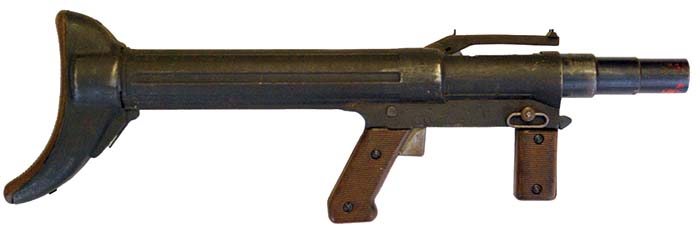
Weapon Number 10
The second grenade rifle, with the factory marking Waffenwerke Brünn, but without model designation, is very different. It is a somewhat futuristic looking weapon, with a relatively simple construction. This version has a tilting barrel, similar to that of an air rifle. The mechanism consists of the rifled barrel, hinged between two wings of the receiver. Behind the barrel is a locking latch, which also serves as the upper part of the cartridge chamber. The latch looks like an inverted U. Its legs have notches, which fall into recesses in the receiver and thus hold the barrel closed.
As the knurled knob of the latch is pressed, these notches slide out of their recesses and the barrel can be opened. If the barrel is fully opened, two springs push the latch to the rear, which in turn extracts the empty cartridge case. The barrel does not hinge that far open, and space is limited. The top of the housing has a recess to facilitate the loading of a new cartridge.
The firing mechanism of the weapon is completely hidden in the housing, impossible to dismantle without proper tools. Therefore, we can not show any details.

At the left side of the pistol grip is a safety lever, with two positions labeled F (Feuer) and S (Sicher). After the shot, barrel and receiver move backwards inside the housing. On the left side of the frame is a T-shaped pedestal for a grenade sight, with increments up to 331 (!) meters.
Mechanically, this grenade rifle is of brilliant simplicity. Field stripping is a matter of seconds. Barrel and receiver can be pulled forward out of the housing after pressing the latch on the front pistol grip. The sheet metal butt is fixed to the housi
The other two rifles are both marked on the top of the receiver with the name of the factory, Waffen Werke Brünn AG, and the model designation GB SS 43. And there we have pretty much the only thing they have in common, because both function completely differently. Even the model designation is spelled differently. One model shows the SS runes between dashes, the other not.

GB No. 7
This weapon has the lowest serial number; Gewehrgranaten-Büchse No. 7. The weapon has a lot in common in terms of construction with the ZK 424. On the barrel there is a handle, with which it can be turned, and then can be slid open forwards. A cartridge can be placed in the chamber. If the barrel is closed, the handle acts as a front pistol grip.
With its typical flare-shaped mouth, the weapon looks like a combination between a rocket launcher and a pirate gun. Although it looks fairly simple on the outside, the interior is just as complicated as the ZK 424. Weapon No. 7 has a sheet steel receiver, consisting of two parts. The rear part has the butt, main spring, breech block and the firing mechanism. The front part contains the barrel and the front pistol grip. This piece acts in fact as a barrel shroud. To load the rifle, the catch behind the front pistol grip must be pressed. The barrel jacket and barrel can be turned 90 degrees clockwise and pushed forward. Subsequently, an ignition cartridge can be loaded in the chamber.
The barrel of No. 7 has two lugs at the rear, just like the ZK 424. These lugs rest in recesses in the front of the breech block. Again, the firing pin spring is cocked when the barrel is rotated to open. However, unlike the ZK 424, the breech block does not consist of two parts, but of only one, albeit in the form of a very complex milled piece.

Number 7 again has a huge main spring, which is enclosed between two caps. The front cap lies around the breech block, the rear around a perfectly fitting wooden plug, which in turn rests against the inside of the butt-plate. When the shot is fired, barrel and breechblock recoil together and here again a ‘limiter’ inside the breech block captures them in their forward movement.
Grenade Rifle number 7 has a huge trigger guard, so that the weapon can also be operated while wearing gloves. The safety is on the left of the trigger housing, with the markings F (Feuer) and S (Sicher). Above the trigger is a bracket for the grenade sight. This is virtually identical in construction to that of weapon No. 10, but has a different graduation. This sight runs up to 200 meters. At the right of the butt plate and on the barrel shroud are two sling swivels to carry the weapon across the shoulder. On the left side of the receiver is a leather cheek piece, but this has only very limited use. The front and rear sights are positioned so far to the left that the head of the shooter, while aiming, does not even come near the cheek piece. Apart from that, the grenade sight is not practical either: at most distances, the hand that grasps the front pistol grip blocks the view between front sight and target.
The sheet steel receiver/housing of this Grenade Rifle is a masterpiece of industrial design and engineering, very suitable for mass production. This contrasts sharply with the extremely complex shape of the barrel and breech block. The usefulness of the flared-shaped mouth is unclear.

GB No. 11
We do not know what is meant by the Roman numeral “IV” after the serial number on Gewehrgranaten-Büchse number 11 – IV. The fourth version? In any case, it is a weapon with a tilting barrel again. The construction of the barrel and the receiver resemble that of the weapon with number 10, with an almost identical locking pawl annex ejector. However, number 11 has a very different mechanism to absorb recoil. It is the only weapon we have ever seen with a friction brake.
The housing of Gewehrgranatenbüchse number 11 has a cross-shaped cross section. In the left and right arm of the cross there are two rectangular guide rods. The receiver has double wings at the left and right. The wings fit exactly in the lateral arms of the housing, wherein the guide rods come to lie on both sides, between the two wings. Around the guide rods are two mainsprings. Through this construction the massive mainspring of the grenade rifles has been replaced by a smaller and more easily manageable double spring. The designers were apparently not sure that this double mainspring could adequately dampen the massive recoil, so they included an extra friction brake. The top of the tailpiece has an elongated slot with three circular cut-outs. In these cut-outs rest three springs and on top of those lies a steel block; a friction-resistant material (probably asbestos). The springs press that block against the inside of the housing. With the recoil of the barrel and breech, the friction between asbestos and housing creates an additional delay. If all this was not sufficient, then there was the unique butt plate. Between the wooden butt plate and its metal mounting are two heavy coil springs, to spare the shoulder of the shooter.

Just as with weapon number 10, the wooden handles of this weapon resemble closely those of the vz. 26. In this case, however, they are newly created with some minor adjustments. To tilt the barrel open, a kind of trigger in front of the front pistol grip must be pressed, after which the pistol grip can pivot inward. The narrowed upward section of this grip pushes the barrel open when it is pressed inward. The ejector, a bridge piece fitted with two axes in the rear part of the barrel, then springs out.
The trigger mechanism is a simplified version of that of the ZK 424. The trigger has a U-shaped extension, which keeps the firing pin cocked. When the trigger is pulled, the front of this extension pivots downward and releases the firing pin. A sliding plate functions as a safety. In its rearmost position, a tongue on the plate covers the extension and blocs its movement. This “safety catch” has no markings.
Gewehrgranaten-Büchse 11 has a similar grenade sight on the left side of the housing as number 10 and number 7, with the same flaws: Only if the weapon is held at an angle greater than 45 degrees can you use the front sight by looking underneath the front pistol grip.

Shutdown
On July 14 and 15, 1944, the Special Committee on Infantry Weapons officially held its first meeting in Berlin. During the meeting, all weapons projects on the list of April were scrutinized. Most of the developments were stopped. This included the construction of a Gewehrgranaten-Büchse in Brno. It marked the end of this fascinating development.
If one looks at the weapons from an engineering point of view, one quickly gets the idea that there were two different (teams of) constructors; one designing the relatively simple tilting barrel weapons, and the other for the much more complicated guns with rotating barrel. In the absence of concrete information, there is unfortunately not much more to say. Production numbers, planned deployment, the type of ignition cartridges; all remain unclear. Apart from that, we are of course delighted that these four unique weapons can be shown. And maybe the story will have an ending just for submitting this article as we learned that there are two or three more Gewehrgranat-Büchsen in the museum in Prague.
(Thanks to Jan Skramoušský of the Vojenský Historický Ustav (VHU) in Prague.)
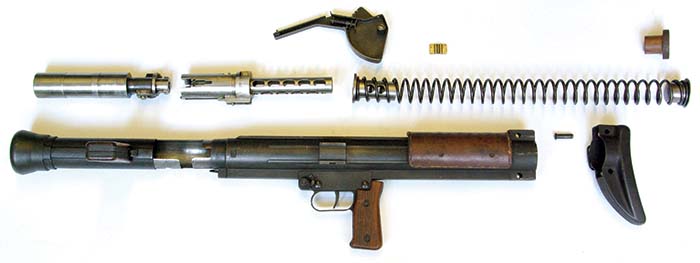
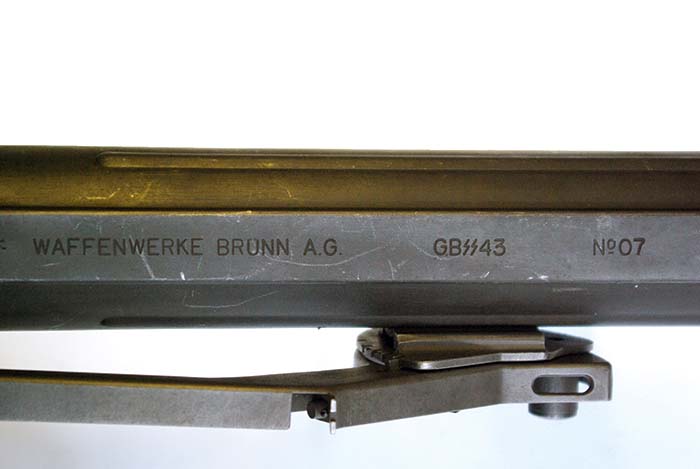


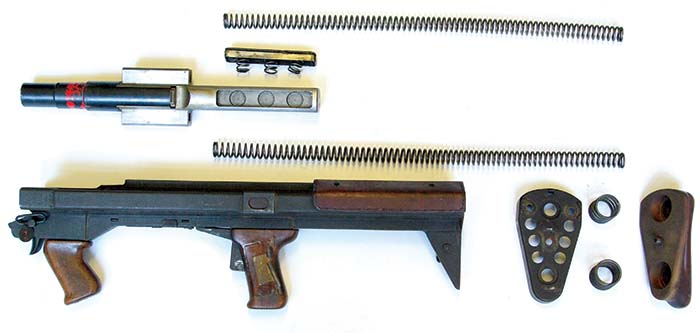
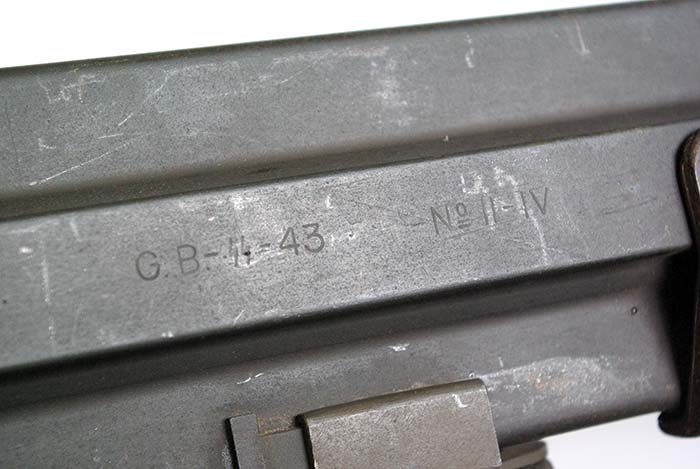
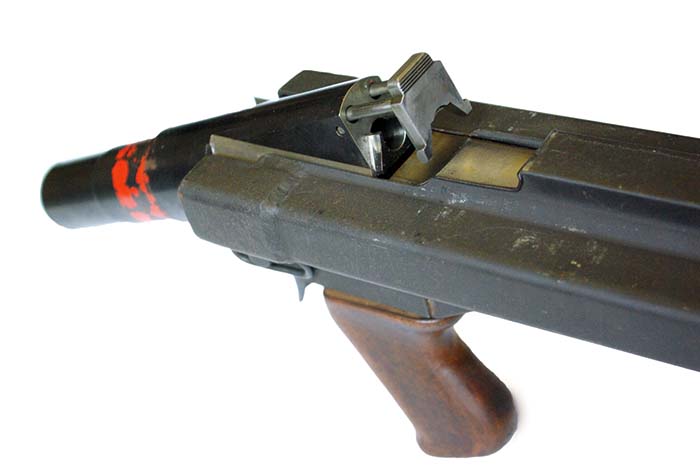
| This article first appeared in Small Arms Review V18N5 (October 2014) |











